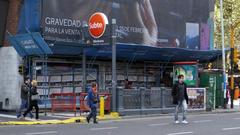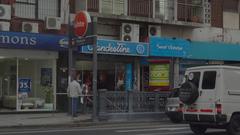
Medrano Almagro Buenos Aires Visiting Hours, Tickets, and Historical Sites Guide
Date: 15/06/2025
Introduction: Medrano-Almagro’s Historical and Cultural Importance
Medrano-Almagro is a vibrant, culturally significant neighborhood in Buenos Aires that stands out as a living testament to Argentina’s layered history and enduring artistic spirit. As the birthplace of tango and home to remarkable landmarks like the Carlos Gardel Museum and the San Carlos Convent Monument, this district encapsulates the evolution of a community shaped by waves of immigration, urban development, and creative energy. The area’s origins date back to the 18th century, transforming from rural estates into a bustling urban enclave following significant Basque and Italian immigration in the late 19th and early 20th centuries (Wikipedia).
Today, Medrano-Almagro is celebrated for its architectural gems such as the San Carlos Church, iconic cafés like Las Violetas, and immersive tango venues that echo the rhythms of everyday porteño life. The neighborhood’s dynamic arts scene, alternative theaters, and bustling markets offer visitors a window into both tradition and contemporary culture. Accessible via multiple subway lines, bus routes, and walkable streets, Medrano-Almagro is an essential addition to any Buenos Aires itinerary (Wander Argentina, Secrets of Buenos Aires).
This guide is designed to equip you with all the details needed to explore Medrano-Almagro’s historical sites, cultural landmarks, and local gems—helping you discover the heart and soul of one of Buenos Aires’ most celebrated neighborhoods.
Table of Contents
- Historical Development of Medrano-Almagro
- Architectural and Urban Heritage
- Visitor Information: Hours, Tickets & Accessibility
- Transportation and Getting There
- Cultural Scene and Community Life
- Local Tips for Visitors
- Frequently Asked Questions (FAQs)
- Notable Residents and Legacy
- Main Attractions and Unique Experiences
- Visiting the Carlos Gardel Museum
- Transportation, Safety, and Practical Tips
- Final Tips and Summary
- References and Resources
Historical Development of Medrano-Almagro
Early Land Ownership and Urbanization
During the 18th century, the area was split between two influential landowners: Portuguese merchant Carlos de los Santos Valente (west) and Spanish barrister Juan María de Almagro y de la Torre (east and north). Initially, the land was agricultural, dotted with dairy farms and brick factories. Urbanization accelerated after the area was incorporated into the Federal District in 1880, spurred by the construction of the San Carlos Church (1878), the arrival of tramways, and a surge of European immigration (Wikipedia).
Immigration and Social Fabric
Between 1880 and 1930, Buenos Aires’ population swelled due to massive European immigration, with Almagro becoming a cosmopolitan hub for Basques, Italians, and other ethnic groups (Global Urban History). The construction of “conventillos” (tenement houses) and “casa chorizo” homes reflected the challenges and dynamism of this urban transformation.
Tango and Cultural Identity
Almagro’s role in the development of tango is central to its identity. Immigrant communities fostered this music and dance in local cafés and social clubs, with the area closely linked to Carlos Gardel, who famously recorded the tango “Almagro” in 1930. Venues like the Casa del Tango and local milongas continue to keep the tango tradition alive (Wander Argentina).
Architectural and Urban Heritage
Notable Landmarks and Institutions
- San Carlos Church & Basilica: A Romanesque Revival masterpiece completed in 1878, open daily 9:00 AM–7:00 PM, free entry (Wander Argentina).
- Café Las Violetas: Belle Époque architecture and pastries, open daily 8:00 AM–midnight; reservations advised on weekends (Gringo in Buenos Aires).
- Plaza Almagro: A community hub with a Sunday book fair, open 10:00 AM–6:00 PM, free entry (Wikipedia).
- Almagro Flower Market: One of the world’s largest, open daily 7:00 AM–8:00 PM (Gringo in Buenos Aires).
Visitor Information: Hours, Tickets & Accessibility
- Most landmarks are free to enter; tango shows and Casa del Tango require tickets (ARS 800–1500).
- Guided tours: Available through local agencies, typically 2–3 hours, starting at ARS 2500.
- Accessibility: Major sites and public transport are generally accessible, though some historic buildings have limited access.
Transportation and Getting There
- Subway: Line B (Medrano station) and Line A (Castro Barros station) connect Almagro to the city (Wander Argentina).
- Buses: Lines 19, 128, 160, 168 serve the area (Wikipedia).
- Major Avenues: Corrientes, Rivadavia, and Medrano streets facilitate navigation.
Cultural Scene and Community Life
Alternative Theater and the Arts
Almagro’s alternative theater scene (“teatro under”) thrives in independent playhouses and cultural centers, offering live music, poetry, and visual arts (Wander Argentina).
Festivals and Local Traditions
September 28 is Almagro Day, marked by neighborhood-wide celebrations. Regular events include the Sunday book fair at Plaza Almagro and the artisan market at Parque Centenario.
Local Tips for Visitors
- Almagro is less touristy and offers an authentic Buenos Aires experience (Gringo in Buenos Aires).
- Sundays are especially lively with markets and fairs.
- Enjoy classic pastries at Café Las Violetas and explore local milongas for tango.
Frequently Asked Questions (FAQs)
Q: What are the visiting hours for main attractions?
A: Landmarks like San Carlos Church and Plaza Almagro are open daily, typically 9:00 AM–7:00 PM.
Q: Are most sites free to enter?
A: Yes; tickets are only needed for certain tango shows and museums.
Q: Is Almagro accessible?
A: Most public transport and major sites are accessible.
Q: How do I get there by public transport?
A: Use Subte Line B (Medrano) or Line A (Castro Barros), or buses 19, 128, 160, 168.
Notable Residents and Legacy
- Carlos Gardel: Tango icon.
- Osvaldo Pugliese: Composer and Casa del Tango founder.
- Alfonsina Storni: Poet.
- Luis Ángel Firpo: Boxer.
- Juan B. Justo: Politician (Wikipedia).
Main Attractions and Unique Experiences
Tango Heritage and Cultural Landmarks
- Museo Casa Carlos Gardel: Gardel’s childhood home, open Tue–Sun 11:00 AM–6:00 PM. Tickets: ARS 350 (Museo Casa Carlos Gardel).
- Milongas: Salón Canning and La Catedral Club for authentic tango (check websites for schedules).
Historic Cafés and Architectural Gems
- Las Violetas: Belle Époque café, open 8:00 AM–midnight (Las Violetas).
- Walking Tours: Explore Art Nouveau and Italianate architecture with local guides.
Parks, Markets, and Local Life
- Parque Centenario: Large park with weekend artisan markets (Parque Centenario).
- Book Fairs: Daily in nearby Parque Rivadavia.
Gastronomy and Nightlife
- Bodegones: Traditional eateries with Argentine classics.
- Parrillas: Steakhouses serving grilled meats.
- Craft Beer and Cafés: Almagro Beer Co. and trendy bakeries.
Shopping and Vintage Finds
- Boutiques and Vintage Shops: Retro clothing, records, and antiques.
- Abasto Shopping Mall: International brands and entertainment (Abasto Shopping Mall).
Unique Experiences and Insider Tips
- Discover hidden tango venues and attend cooking classes to learn Argentine recipes.
- Almagro is safe, but follow standard urban precautions.
Visiting the Carlos Gardel Museum
- Location: Jean Jaurès street, housed in Gardel’s childhood home.
- Hours: Tue–Sun, 11:00 AM–6:00 PM; closed Mondays.
- Tickets: ARS 350; discounts for students/seniors.
- Tours: Guided tours at 11:00 AM and 3:00 PM.
- Accessibility: Wheelchair accessible.
- Nearby: Café Las Violetas, vibrant murals on Jean Jaurès.
- Getting There: Medrano (Line B) or Castro Barros (Line A) stations.
San Carlos Convent Monument: History, Visiting Hours, and Tickets
- Location: Central Medrano-Almagro.
- History: 18th-century convent, now a museum and event space.
- Hours: Tue–Sun, 10:00 AM–6:00 PM; closed Mondays.
- Tickets: ARS 150; discounts for students/seniors. Online purchase available.
- Tours: Spanish daily; English on weekends by reservation.
- Events: Tango nights, lectures, exhibitions.
Getting Around: Transportation Guide
- Subway (Subte): Medrano station (Line B), Castro Barros (Line A). Trains run 5:30 AM–midnight (Secrets of Buenos Aires).
- Buses (Colectivos): Multiple routes, including the useful 152 (Sol Salute).
- Taxis/Ride-Sharing: Radio taxis, Uber, Cabify; fares $2–5 USD (Short Girl on Tour).
- Walking/Cycling: Walkable neighborhood; Ecobici bike-sharing.
- Trains: Once Station for longer trips.
Safety and Practical Visitor Tips
- General Safety: Mostly safe; beware of pickpockets and motochorros (The Broke Backpacker).
- Emergency: Police 911; hospitals and pharmacies readily available.
- Money: Argentine peso; mix of cash and cards recommended; tipping 10%.
- Language: Spanish; some English in tourist spots.
- Connectivity: Local SIM cards, free Wi-Fi in many venues.
- Etiquette: Late dinners, smart-casual dress, expect warm greetings.
- Weather: Summers are hot/humid; winters mild.
- Accessibility: Most main sites accessible, but some older buildings have stairs.
- Cultural Experiences: Attend a milonga, enjoy traditional cafés and bodegones (Buenos Aires Connect).
- Useful Apps: Transit, Moovit, Google Maps, Uber.
Summary and Final Tips
Medrano-Almagro epitomizes Buenos Aires’ blend of history, culture, and community. From the colonial-era San Carlos Convent Monument and the stunning San Carlos Church to the living legacy of tango at the Carlos Gardel Museum, the neighborhood invites exploration well beyond the tourist trail (Wikipedia). Enjoy Belle Époque cafés, bustling markets, and authentic bodegones, all within a walkable and well-connected locale (Secrets of Buenos Aires).
For the best experience, take part in guided tours, food tastings, and cultural workshops. Stay updated on local events by using the Audiala app and trusted local resources. Whether you’re a history buff, tango lover, or curious traveler, Medrano-Almagro promises a rewarding, memorable visit.
References
- Almagro, Buenos Aires, Wikipedia
- Museo Casa Carlos Gardel, Buenos Aires City Government
- Wander Argentina, Almagro Neighborhood Guide
- Secrets of Buenos Aires, Public Transport Getting Around
- Sol Salute, Buenos Aires Public Transportation
- Short Girl on Tour, Tips for Visiting Buenos Aires
- Buenos Aires Connect, Almagro Cultural Scene































































































































































